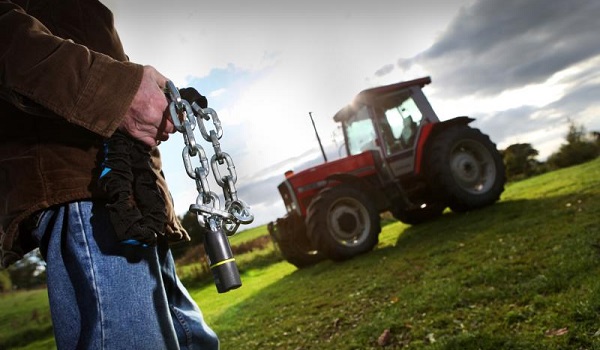The need for intelligence-led rural policing
Steve Dodd examines how community intelligence-led policing can help tackle crime in rural communities.
The value of our countryside, its rural landscapes, habitats and outdoors areas, are vital to the economic and social wellbeing of the UK.
The National Trust’s managed sites at Arlington Court in north Devon, Wallington in Northumberland, the Peak District and the Yorkshire Dales recently received £5 million off the Garfield Weston Foundation with the aim to restore habitats such as blanket bog, wetlands, wood pasture and rivers are but one example. Illustrated alongside community support collectives such as the ones at the Attenborough Nature Reserve in Nottinghamshire or the National Space Centre near Leicester emphasising the importance of rural initiatives on health and happiness.
In economic terms the food and farming industry generates more than £128 billion a year for the UK economy and more than £14 billion in gross value added (GVA) through domestic tourism (Countryside Alliance), providing wealth, employment and leisure opportunities.
Delving deeper into the issue, the House of Lords provided a briefing for the UK Parliament in 2020. The report estimated rural areas contributed £261 billion to England’s total economy (GVA). It stated the Welsh government estimated 78 per cent of land in Wales is used for agriculture; its forestry, fishing and agriculture and was estimated to have produced £510 million in 2017.
The briefing further stated 90 per cent of England is made up of rural areas, and that 71 per cent of UK landmass is agricultural. Putting further context to the debate, only five years ago, 20.9 per cent of England’s population lived in local authority areas defined as predominantly rural; in Wales the figure was 32.8 per cent.
Allowing statistics to further influence this illustrative; in general terms of GVA, rural areas contributed 16 per cent of economic output, whereas London came in at 28 per cent and the remaining predominantly urban areas 45 per cent.
Political fabrication of commitment to strengthening rural communities will invariably be exposed, for it was George Orwell, I believe, who said, “clear language is a victim of insincerity”; likewise, rhetoric and arbitrary promises at some point in time require materialisation or risk becoming hyperbole.
The general public and businesses across the countryside require policing to address their needs; contrastingly, police forces require staff, funding, autonomy and revised legislation.
Taking oral questions at the Dispatch Box in the Commons Chamber in March, Home Secretary Yvette Cooper responded to concerns raised by Dave Robertson MP with: “My constituents in Airedale and Chequerfield see the total nightmare of off-road bikes being driven deliberately to harass people. If we have to wait for the police to give multiple warnings, they cannot take the swift action needed, which is why we need the change in the Bill.”
In the same debate, Policing Minister Dame Diana Johnson reassured the Chamber: “On the issue of serious crime in rural areas, our Neighbourhood Policing Guarantee will deliver thousands of neighbourhood police community support officers across England and Wales, including in rural areas, to speed up response times, build up public confidence and ensure that for those violent criminals who commit acts such as armed robbery, there will be no hiding place from the law.”
In response to a question by Paul Davies MP from West Yorkshire on tackling rural crime, Dame Diana cited work with the National Police Chiefs’ Council on the next iteration of the rural and wildlife crime strategy. “Later this year we will implement the Equipment Theft (Prevention) Act 2023 and put the necessary secondary legislation in place”, the minister confirmed.
The Home Secretary on the BBC’s Laura Kuenssberg show reiterated policing’s operational independence, underscoring the fact public attention is not going to abate anytime soon though increased force staffing numbers, legislative enactments, policy announcements, funding guarantees and roll-out of College of Policing national training programmes, all promote prosperity of service.
Intensified scrutiny is responded to by an innate demand for an uplift in outcomes; police targets become almost materialistic, as seen in publicity stratagems, anti-crime campaigns, community partnership working, action planning, citizen engagement programmes and a plethora of local social initiatives, because failure could ultimately appear to be catastrophic for the credibility of the Prime Minister’s pledge to “take back our streets”, affirmed as it is through the Safer Streets mission. Community Safety is that social contract.
Public acceptance is one thing; confronting the task is all too real.
Lake Windemere has visitor numbers of seven million a year, policed by the Cumbria force of just 1,383 officers. Dyfed-Powys Police has 1,294 officers yet covers two-thirds of Wales’ landmass; Lincolnshire just 1,198 officers. By comparison, the Metropolitan Police Service (MPS) has a strength 34,315. Expanding comparisons. I believe Cumbria Constabulary has 74 neighbourhood officers, the MPS 2,131, whereas Greater Manchester Police has 666 officers assigned neighbourhood duties, with Dyfed-Powys Police coming in at 40; and Leicestershire Police 228 out of an establishment of 2,248. One thing these figures do highlight though is the autonomous discretion of chief constables through independence of office.
The scale of the issue is all-encompassing; the opposite side of the coin is as equally daunting because dissatisfaction goes both ways. As Brian Booth, acting deputy national chair at the Police Federation of England and Wales, previously explained: “With pay down 21 per cent in real terms since 2009, resignations up 142 per cent since 2018 and nearly a quarter of officers planning to leave, instead of attacking frontline (police) officers we should be asking why more than a decade of government inaction is leaving them overworked, underpaid, and under threat.”
Policing does not discriminate; it is proportional, independent, apolitical and unbiased; its unilateral application is free from external influence. This is no epitaph, nor is it an analysis, what I do quote is the Policing Minister’s Parliamentary statement in March: “Too often victims of crime in rural communities have been left feeling undervalued and isolated, whether it be famers having equipment or livestock stolen, or villages targeted by car thieves and County Lines gangs…”
A government policy paper published in April highlighted 15 new policing measures at an annual cost of £48.65 million.
And in March, the Government announced £800,000 in funding for the continued work of National Rural Crime Unit and National Wildlife Crime Unit for a year, both vital in the battle against rural and wildlife crime, but this is equivalent to only an approximate additional £18,500 per force. If rural funding is an ill-defined argument where does that leave a pragmatic approach. Country Land and Business Association (CLA) president Victoria Vyvyan said in the same announcement: “As recent CLA analysis found, some police forces lack dedicated rural officers and basic kit.”
In practical community policing terms ‘local’ is not a geographical constraint: the National Rural Crime Network’s England and Wales figures for 2022 are stark; theft of agricultural vehicles and machinery up 29 per cent to £11,700,000, while NFU Mutual’s estimation of the cost of rural crime in 2023 was £52,800,000.
An indictment of rural policing is all too obvious for farmers across vast swathes of the country, for market hamlets and village communities alike, to isolated small holdings, even to police forces and their specialist teams. The catastrophe of rural support has been escalating as our present position is the culmination of neglect of far more than a decade in the making.
Neighbourhood policing can contribute enormously to improve the decline of service provision: the British Retail Consortium (BRC) quotes 61 per cent of retailers rate police response to crime as poor or very poor; the Countryside Alliance’s rural charter states 50 per cent of people in rural areas do not think police take rural crime seriously. The BRC highlights just 32 per cent of crimes in 2024 were reported to the police; likewise the Countryside Alliance states one in three people who were victim of crime did not report it. Furthermore, 44 per cent of people in rural areas felt intimidated by criminality or criminals in the past year, corroborated by 45,000 annual incidents of violence in the retail sector. There is an acceptance that our huge metropolitan cities and vast urban townscapes contain the volume of crime but there is less consensus that rural crime is more difficult to confront.
Using North Yorkshire as an illustration; a force looking after a population of around 830,000 in its jurisdiction of 3,210 square miles, which contains a 6,000 mile roadway network and 55 miles of coastline. The force covers the third largest geographical area in England and Wales, assigning 231 officers to neighbourhood duties out of a contingent of 1,681 (15th smallest). There were more than 46,000 recorded crimes, 18,624 offences of violence against the person, according to Crime Survey data, compared with 280,000 offences committed in West Yorkshire, 333,000 crimes in Greater Manchester and more than 900,000 in London, where their community resources stand at: 400, 666 and 2,131 respectively. It is not a competition; each must be equally protected.
In the case of Leicestershire Police, collated in the Home Office’s grouping of the East Midlands cluster, statistics are noteworthy: 96,411 total crimes recorded. Second highest figure in the grouping for violence against the person (35,574); second highest recorded sexual offences (3,780); likewise with stalking (11,967), robbery (893) and also the highest for residential burglary (3,849), bike thefts (1,323), non-residential burglary (1,459) and vehicle offences (6,811).
There are many elements to neighbourhood policing; an embodiment of rural intelligence-led policing is assimilation, the practical application of observation, it is understanding the elements of cohesion within a collaborative picture. Where police intelligence is corroborated information, community intelligence is vigilance of patrol, emphasis on communication, integration, local knowledge while cognisant of the new, unknown, unattributed, indistinguishable, undefined, or irrelevant – this is community safety, this is intelligence-led policing, a structured framework for information capture, recording, process and analysis.
A Community Intelligence-Led Policing Methodology will sit equally as well for independent forces as it will for those with interoperability arrangements in place. Sharing of information or perhaps more accurately, accessing material is essential in confronting rural crime.
Obtaining the data in the first place is the greatest problem for policing as evaluation of online community incident logs, crime complaints, occurrence reports and graded intelligence submissions do not provide sufficient depth for analysis.
The pooling of information or disclosure of specific knowledge across specialised units and forces similarly has revolutionised the fight against opportunist criminal gangs and organised crime alike. Where development is required is in a laminated all-encompassing protocol at grassroots level across England and Wales to confront rural crime.
The Prime Minister’s determination to “take back our streets” manifests itself in what Policing Minister Dame Diana said on the Government website in support of the rural funding announcement: “This new funding, alongside the forthcoming Rural and Wildlife Crime Strategy and our Neighbourhood Policing Guarantee, will help deliver the change rural communities deserve, ensuring no matter where you live your streets are safe and police responsive to your local needs as we continue to deliver on our Plan for Change.”
Support for the announcement was extensive. Secretary of State for the Environment, Food and Rural Affairs Steve Reed said: “For too long, rural crime has gone unpunished… This government will crackdown on these criminals and bring them to justice with specialist rural policing units to protect farmers and our rural communities.”
Superintendent Andrew Huddleston, head of National Rural Crime Unit said: ‘This funding is critical and will enable information sharing and joint operations to continue across the UK.’
Chief Inspector Kevin Lacks-Kelly, head of UK Wildlife Crime, added: ‘This funding is a significant step forward in the fight against wildlife crime.”
Almost seven years on from the Rural Crime and Public Services parliamentary debate on June 6, 2018, the consensus is magnified by reminisces of time, experience and procrastination:
Moving that debate, Louise Haigh MP for Sheffield Heeley, said: “In the most recent year for which figures are available, more than 88,000 farm animals were snatched by thieves, amounting to more than £6 million in lost stock to farmers, with the consequential impacts on our rural economy…
“Last year, Humberside Police spent 1,200 hours battling hare coursing, with more than 500 reports of the crime in the 2017/18 season…
“In the Devon and Cornwall force, not only is the chief constable responsible for an area of almost 4,000 square miles… he is also responsible for 500 miles of coastline and for ten miles out to sea.
“If police do not have the ability to reach out, they [vulnerable individuals in rural areas] will feel ever more vulnerable…”
Stephanie Peacock MP for Barnsley East, said in South Yorkshire “the number of insurance claims rose by 54 per cent”.
Chris Elmore Labour MP for Bridgend, said “rural communities are not just places such as Somerset, Devon or Cornwall, but in seats such as mine, former heavy industrial areas”.
Sir John Hayes, MP for for South Holland and The Deepings, said “victims know that nothing will be done about them [crimes] so they do not bother to report them”.
And Peter Grant, former MP for Glenrothes, stressed that “for a victim of crime, the crime rate on that day is 100 per cent”.
The Government’s forthcoming rural crime strategy is going to increase the workload of forces exponentially.
An effective, pragmatic approach is required to not only fight rural crime, but support frontline officers and rural communities alike.
What is inherently clear is a single approach will be inadequate; whereas artificial intelligence and technological advances enhance operational capabilities in the fight against criminal enterprises, what must be realised is it is paramount that resilience, determination, support, understanding, empathy, and a commitment must be exhibited through direct contact actions to reassure each-and-every community in Britain.
North Cornwall’s Ben Maguire, MP, presented a Rural Crime debate in the House of Commons earlier this year. It delivered a startling presentation: 86 per cent of countryside residents say rural crime is negatively impacting their mental wellbeing.
Alex Brewer MP for North East Hampshire informed the debate that 22 active organised crime gangs (OCGs) operated across the country specifically involved in rural crime.
The debate emphasised the true extent and diversity of rural crime; speaker after speaker laid out their constituent’s experiences illustrating the impact of domestic violence, fly-tipping, theft, hare coursing, threats, intimidation and anti-social behaviour. It emphasised the complexity of tackling rural crime and the need for continued development of policing tactics.
Two recent illustrations of rural criminality underline the need for a Community Intelligence-led Policing Methodology (CILPM) approach.
Continuing his presentation, Ben Maguire spoke of a farming couple from Blisland, Cornwall, who had two quad bikes stolen. Police officers attended three days after the theft having to undertake a three-hour round trip from their station in Totnes to attend the scene. in March, Dyfed-Powys Police recovered 63 stolen ewes from three locations after an appeal was shared 700 times and a suspect arrested. Inspector Matthew Howells commented that “the support from the farming communities near and afar has been vitally important in securing a positive outcome”.
Each example in their individual circumstances further demonstrate the need for preventative proactive rural intelligence-led policing.
OCGs move from one target to another dependent on product; significantly, community intelligence mirrors that philosophy – link the targets, prevent victims, identify perpetrators.
Community intelligence-led policing has adaptability within a structured framework and a flexibility of application across the rural environment as it empowers neighbourhood officers to contribute at a deeper level fostering a camaraderie of duty, a unified fight against rural crime.
The integration of community patrolling within rural intelligence-led policing will foster confidence, knowledge, awareness, and unity of kinship, here is the second delineation that manifests in a ‘before, during and after’ countenance. Recording and reporting the insignificant, approaching the indistinguishable, engaging the unknown, questioning the incomprehensible, noticing the imperceptible, confronting the violent, safeguarding the vulnerable, indoctrinating intelligence at the heart of neighbourhood policing.
Rural intelligence-led policing is proactive, ostensibly employing neighbourhood practices with the added quality of comprehension of rural crime’s aetiology. It is mindful of subsequent effects of criminal behaviour within context of disparate communities by viewing perpetuation of crime as determined by its structure in a rural environment, simply put:
- County Lines is relationship between supplier and user networks, [drugs].
- Theft is an association between thief, victim and ‘fence’, [quad bikes, farm machinery].
- Assault is personal between assailant and victim, [domestic abuse, modern slavery].
It is by remaining cognisant of the nature of the crime while mirroring the evolution of its modus operandi as an evolving relationship provides police intelligence with additional insight.
Community intelligence is lamination within CILPM’s Octahedron pyramid, it is top-down direction according bottom-up action set against bottom-down activity reflecting top-up authority; in essence it is a community sourced holistic interpretation of rural criminality.
A collective relationship, a unifying bond of citizen and neighbourhood officer; restored through agreement, built upon trust, instilled with confidence, reinforced by reliability, security and rewarded in community.
Understanding the theory explains the interactions that rural community intelligence-led policing’s foundations are constructed on; the ability of police forces to obtain grassroots word-of-mouth information live-time; corroborated by officer’s own evidence.
It was Jean-Jacques Rousseau’s in his The Social Contract who said: “Each of us puts his person and all his power in common under the supreme direction of the general will.”
Steve Dodd is a retired South Wales Police detective. He is a subject matter expert on police intelligence having authored the force’s Community Intelligence Force Policy. An adviser on the College of Policing’s Intelligence Professionalisation Programme, he was deployed on the Government’s working group on the Western Balkans Serious Organised Crime strategy. An international liaison officer, he is an international airline certified extradition officer, plus National Financial Investigator qualified. He is currently writing his ‘Community Intelligence-Led Policing Methodology’ including the octahedron pyramid, a transtheoretical approach, and an inverted strategy thesis.




